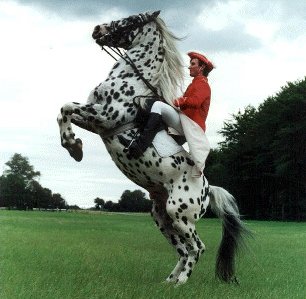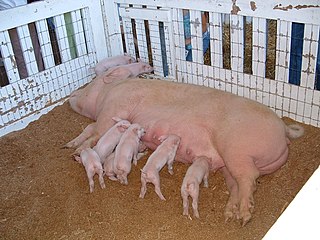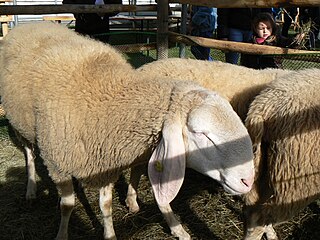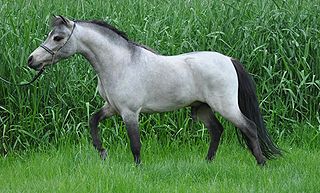
The Charolais or Charolaise is a French breed of taurine beef cattle. It originates in, and is named for, the Charolais area surrounding Charolles, in the Saône-et-Loire department, in the Bourgogne-Franche-Comté region of eastern France.

Vietnamese Pot-bellied is the exonym for the Lon I or I pig, an endangered traditional Vietnamese breed of small domestic pig.

The Knabstrupper or Knabstrup is a Danish breed of warmblood horse. It is principally a riding horse, but is also used as a harness horse and as a circus animal.

The Tamworth is a British breed of domestic pig. It is the only red-coloured British pig. Its origins are unknown, but it appears to have developed near the town of Tamworth in south-eastern Staffordshire, close to Warwickshire border. It is one of seven British pig breeds listed by the Rare Breeds Survival Trust as 'priority', the highest level of concern of the trust.

The Pinzgauer is a breed of domestic cattle from the Pinzgau region of the federal state of Salzburg in Austria. It has distinctive colouring, with chestnut-brown sides and white back and underside. It was in the past a triple-purpose breed, raised for meat, milk and draught use. There is a naturally polled sub-type, the Jochberg Hummel. In 2007 the breed was not considered by the FAO to be at risk.

The American Yorkshire is an American breed of large domestic pig. It is the most numerous pig breed in the United States. It derives from pigs of the British Large White or Yorkshire breed imported from the United Kingdom or from Canada at various times from about 1830 to the mid-twentieth century.

The Lithuanian White is a Lithuanian breed of general-purpose pig. It was developed in the twentieth century in the Lithuanian Soviet Socialist Republic under the Lithuanian Animal Husbandry Research Institute of Baisogala, and was officially recognised in 1967. It derives from cross-breeding of local pigs with imported breeds including the Large White, the Deutsches Edelschwein and the German Landrace. It was bred for suitability to conditions in Lithuania, but spread to other parts of the Soviet Union including those that are now Belarus, Georgia, Kazakhstan, Turkmenistan and Moldova, and was also reared in parts of the Russian Republic.

The Crèvecœur is an endangered historic breed of crested chicken from the Pays d'Auge, in the Calvados département of Normandy, in north-western France. It is named after the commune of Crèvecœur-en-Auge. It is related to the La Flèche and to other Norman breeds such as the Caumont and Caux and the extinct Pavilly; the Merlerault was formerly considered a sub-type of the Crèvecœur.

The British Saddleback is a modern British breed of domestic pig. It was created in 1967 by merging the surviving populations of two traditional saddleback breeds, the Essex and Wessex Saddleback. It is an endangered breed, listed on the watchlist of the Rare Breeds Survival Trust as at risk, the second-highest level of concern.
Miniature cattle are found in various parts of the world. Some, such as the Dexter of Ireland and the Vechur of Kerala, India, are traditional breeds; others have been recently created by selective breeding. The Australian Lowline was the unexpected result of a scientific experiment. Some, but not all, miniature breeds display achondroplasia, or dwarfism.

The Bergamasca is a breed of domestic sheep from the mountainous part of the province of Bergamo, in Lombardy in northern Italy. It originates from the area of the Val Brembana and the Val Seriana valleys, and is particularly associated with the plateau of Clusone. By the beginning of the 20th century it had spread through much of Lombardy; it is now raised in most parts of mainland Italy, particularly the province of Teramo in Abruzzo, where more than 80% of the registered stock are kept. The Bergamasca is also present in Brazil, Serbia and Venezuela. It is raised principally for meat, and is often used for cross-breeding with other meat breeds to improve meat yield. In Lombardy, it is traditionally raised by transhumant management: the herds spend the summers on the alpine pasture, and over-winter in the Po valley.

The Speckle Park is a modern Canadian breed of beef cattle. It was developed in the Canadian province of Saskatchewan from 1959, by cross-breeding stock of the British Aberdeen Angus and Shorthorn breeds; the spotted or speckled pattern for which it is named derived from a single bull with the colour-pointed markings of the British White Park. It is one of only a few beef cattle breeds developed in Canada.

The Balkan donkey or mountain donkey, Serbian: Domaći balkanski magarac, is a breed or group of breeds of domestic donkey originating in the Balkan region. It is reported from Serbia and Montenegro.

The Australian Merino is an Australian breed or group of breeds of sheep, forming a significant part of the Merino group of breeds. Its origins lie in Merino sheep imported to Australia from South Africa in about 1796. By about 1830 there were almost two million Merinos in the country.

The American Miniature Horse is an American breed of small or miniature horse. It has been selectively bred to display in miniature the physical characteristics of a full-sized horse, and usually stands no taller than about 38 in (97 cm). It frequently has the appearance of either a small Arab or a small draft horse; genetically it is no different to pony breeds such as the Shetland.
























